
New Zealand Police inflicted pre-dawn guerrilla warfare tactics, Monday 21 February, when they set-in motion a blockade of eight access and exit points to the Freedom Encampment at Wellington’s Parliament Grounds and surrounding streets.
At approximately 3.30am, police moved in and protected the installation of concrete barriers in eight locations, including Lambton Quay, Mulgrave St, Hill St, Molesworth St, Bunny St and Kate Sheppard Place. At its peak, 300 police guarded the trucks and fork-hoists and periodically clashed with protesters, among who eight were captured for arrest.
The effect of the blocked access points, with half-tonne concrete blocks, is that the supply chain of the occupied zone has been partially cut-off in the capital city. With this chess move, the police have instigated a siege of the occupation.
By Steve ‘Snoopman’ Edwards, 21 February 2022
Monday 21 February 2022: Shortly before 4am, ‘Freedom Village’ on Parliament Grounds awoke to the mantra ‘hold the line’, which is code for the camp to move in the direction of the calls.
Approximately 50 New Zealand Police strode to the end of Kate Shepherd Place, where a stand-off ensued between about 100 anti-mandate occupiers and the Constabulary.
At approximately 4am, a truck bearing the corporate insignia of Lower Hutt-based, LT Transport Ltd, with a flat deck trailer and winch parked-up with its load of concrete blocks.
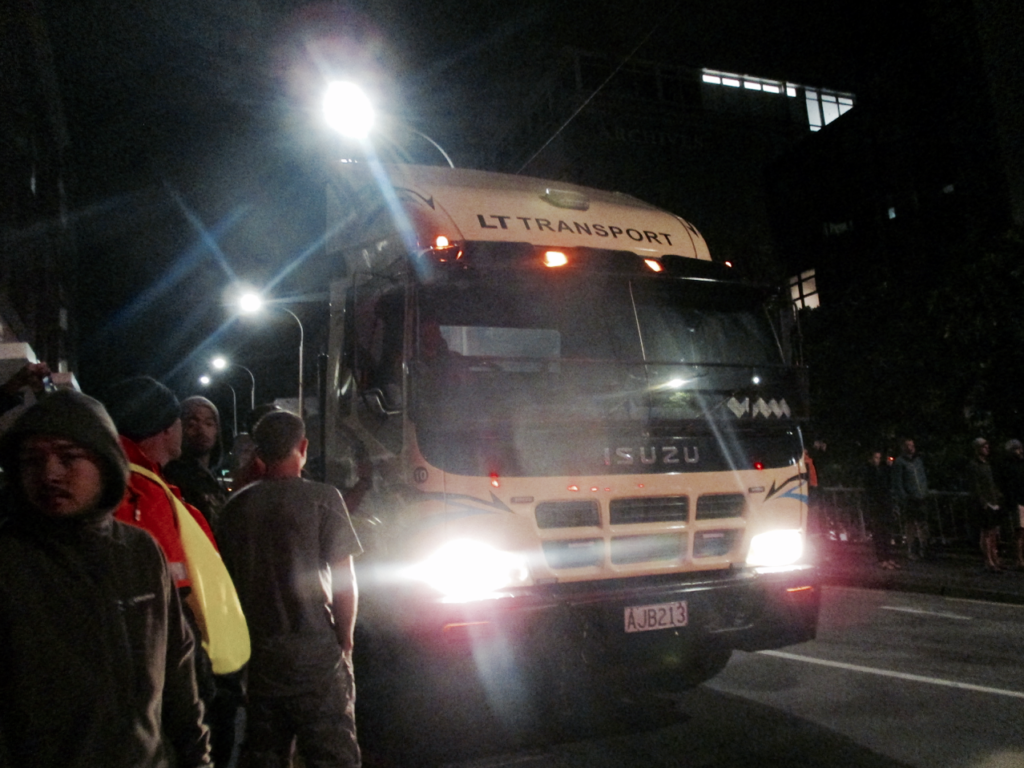
A fork hoist was used to lift the blocks off the truck and set two blocks to partially block Kate Shepherd Place, while a police car was parked to complete the cordon.
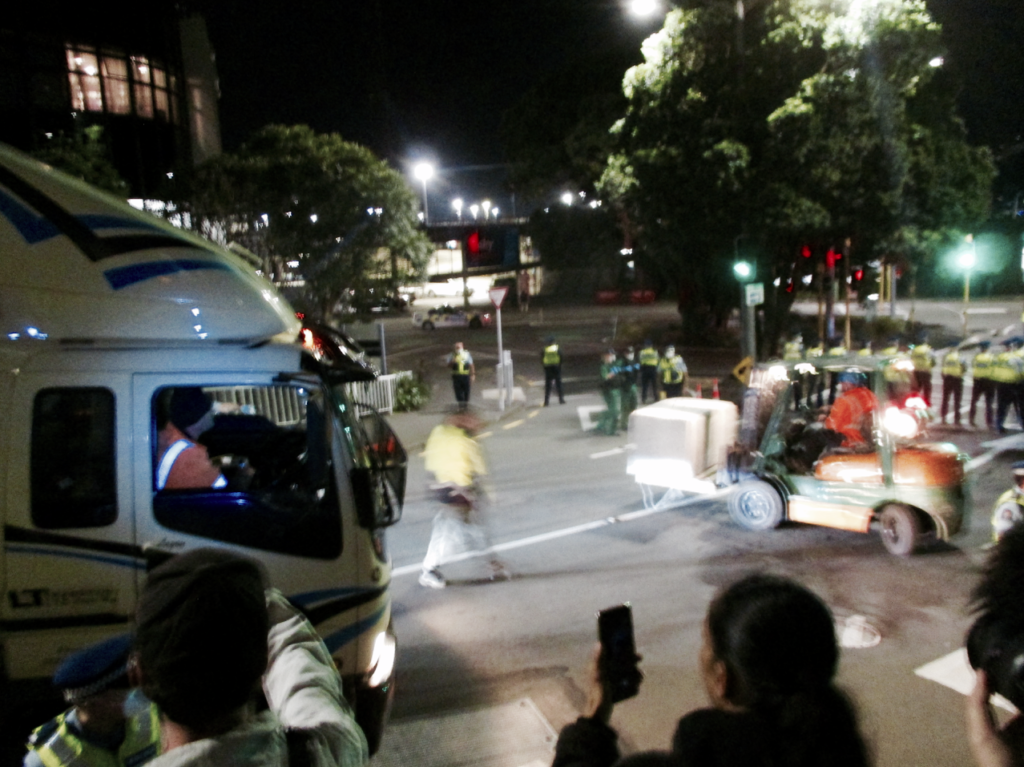
Kate SheppardPlace is the vehicular access for the outdoor kitchen server marquees located on Molesworth Street, which is the main street frontage to Parliament Grounds.

Ironically, Kate Sheppard Place is named after the 19th Century Women’s Suffrage Movement leader, Katherine Wilson Sheppard, who is credited with leading to battle to win women the right to vote in a Westminster-style Parliamentary jurisdiction. This was a world first to extend the Westminster Parliamentary franchise to include women.
While this occurred, some among the protest group verbally abused the truck driver and fork lift operator, as well as police. Several protesters attempted to calm down the most agitated.
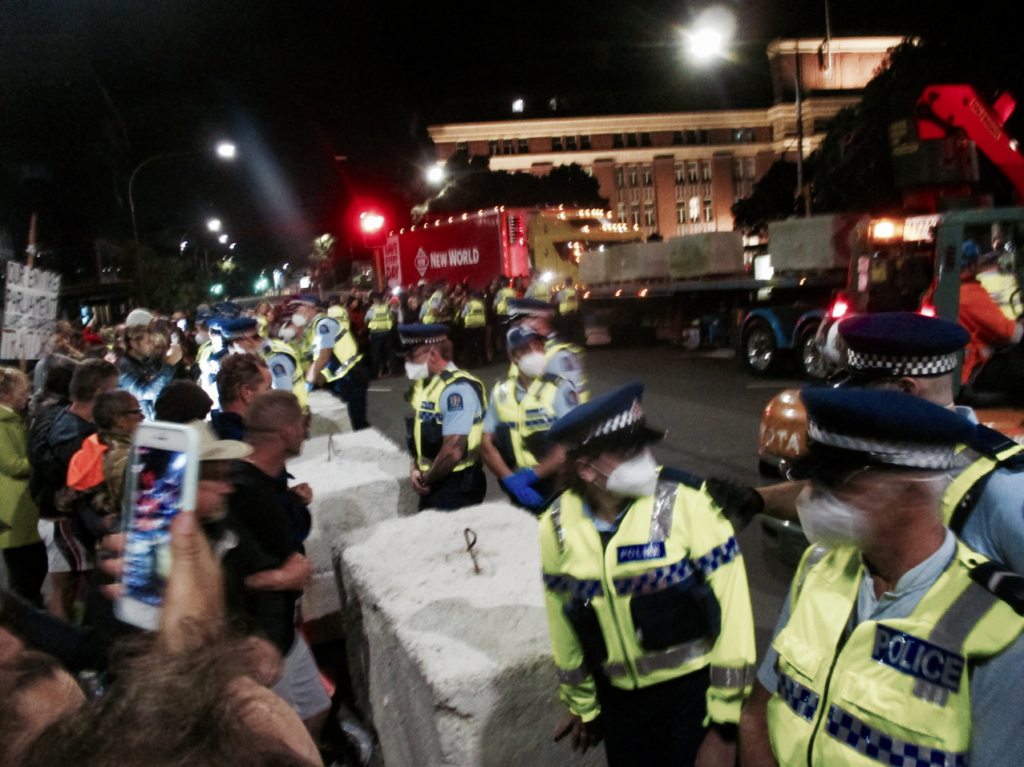
More police arrived as another truck bearing the corporate insignia of Upper Hutt-based, Hammond Crane & Cartage, rolled up with eight blocks.
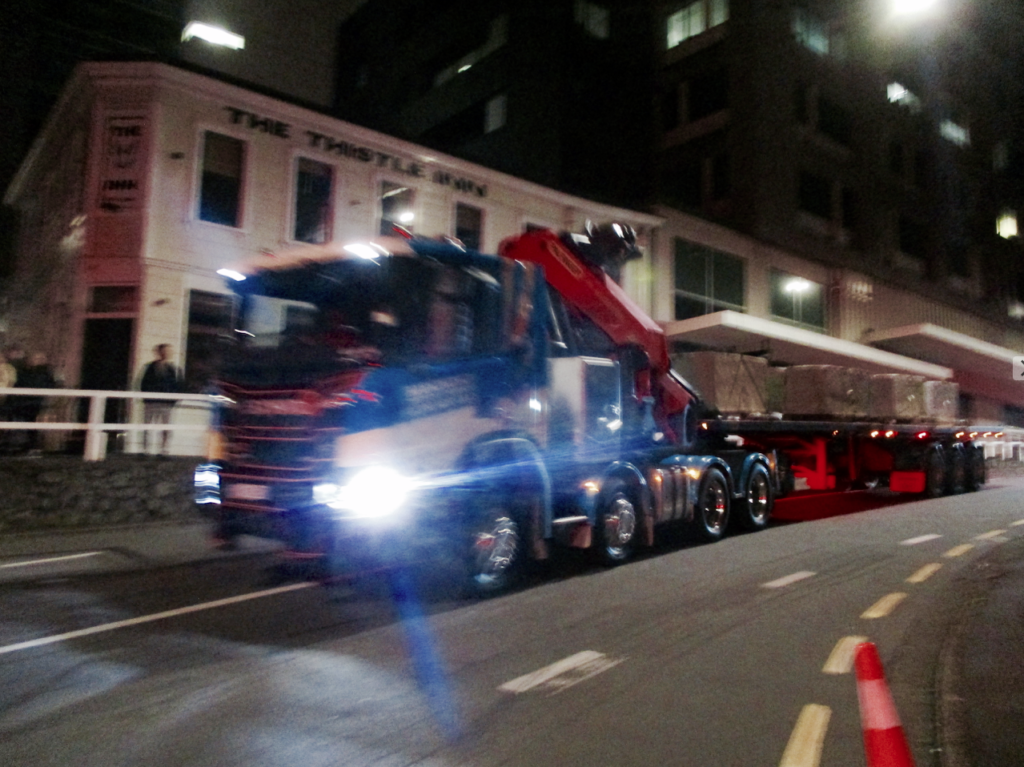
Three blocks were laid to partially block the bus depot exit next to Kate Sheppard Place, while another Police car was used to complete the cordon.

The Bus Station and carpark became another auxilliary encampment since the anti-mandate occupation began on February 8th.
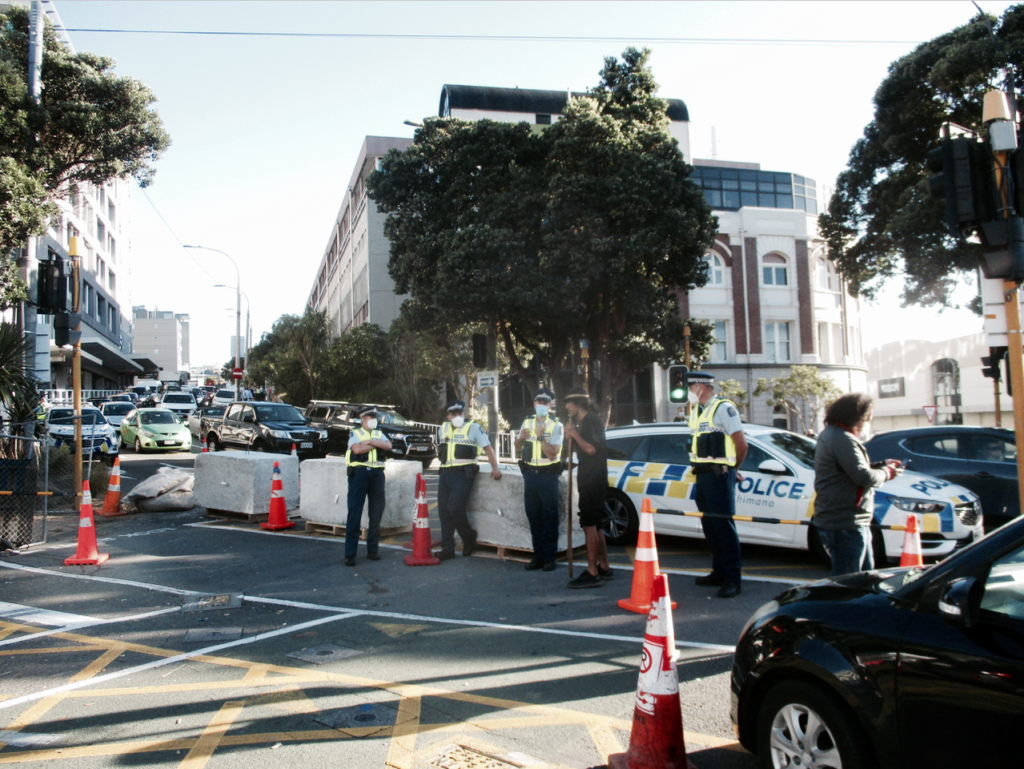
Next, the Police marched around corner to block off the intersection of Bunny Street at the Featherston Street end, which is located across from the Wellington Central Railway Station.
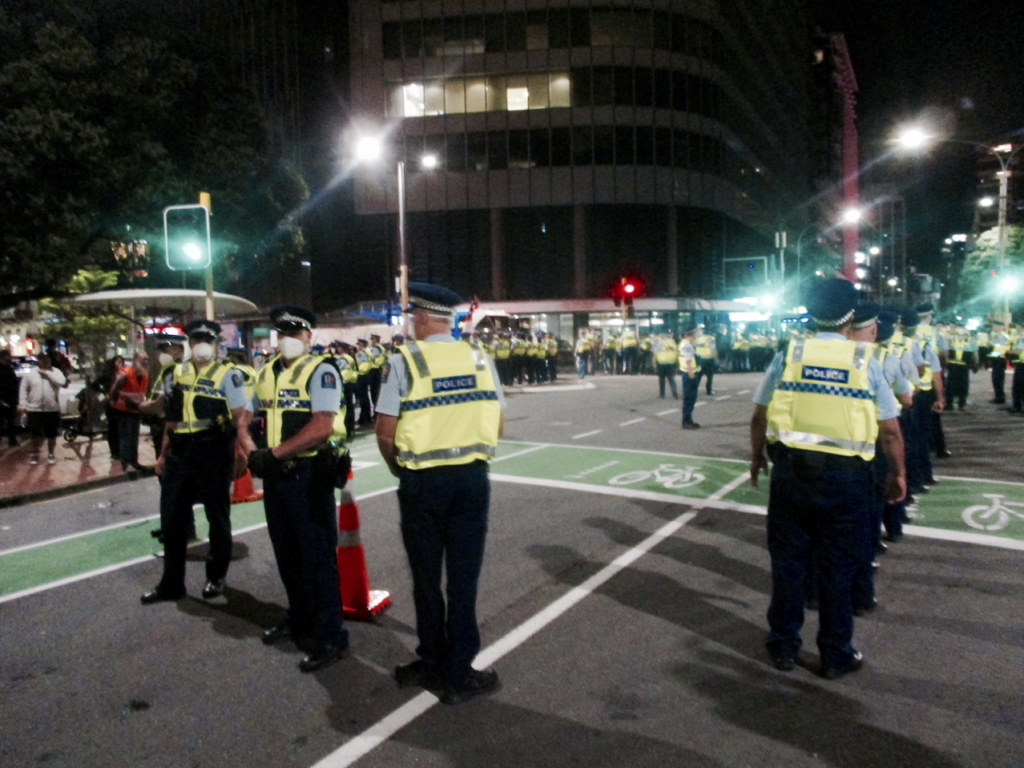
In Bunny Street, there are numerous vehicles, tents and awnings that form one of several auxiliary encampments in the vicinity of New Zealand’s Parliament Grounds.
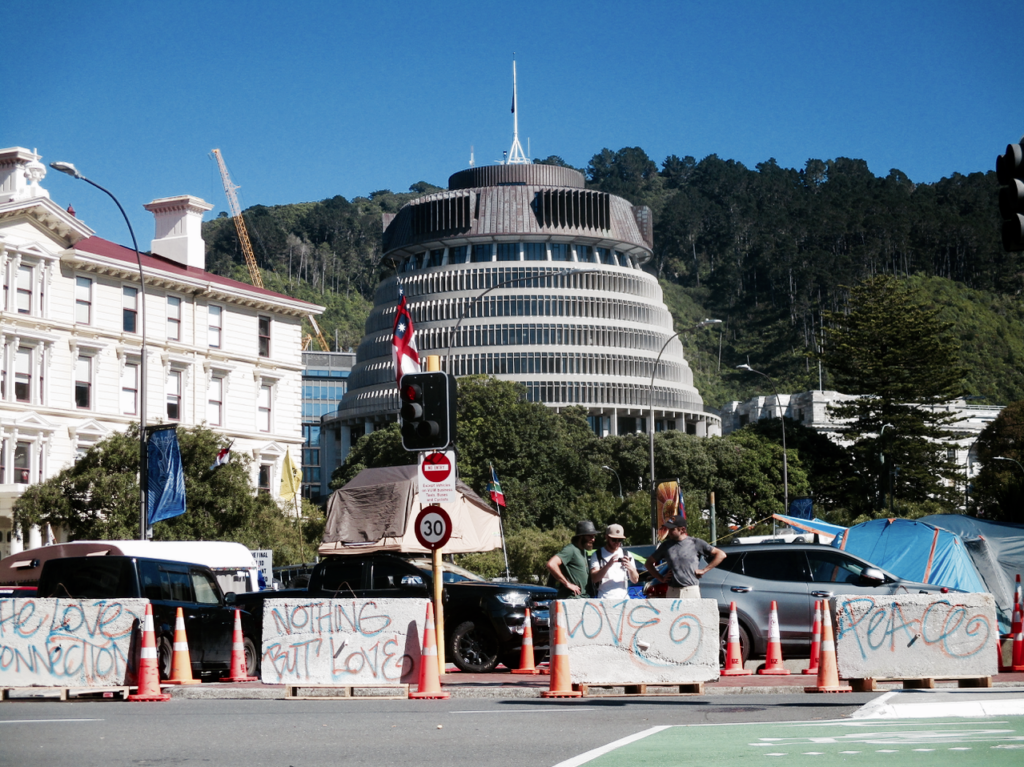
Four trucks from LT Transport and Hammond Crane & Cartage rolled up, amid 300 Police, and a noisy crowd of 250 Liberty Occupiers.
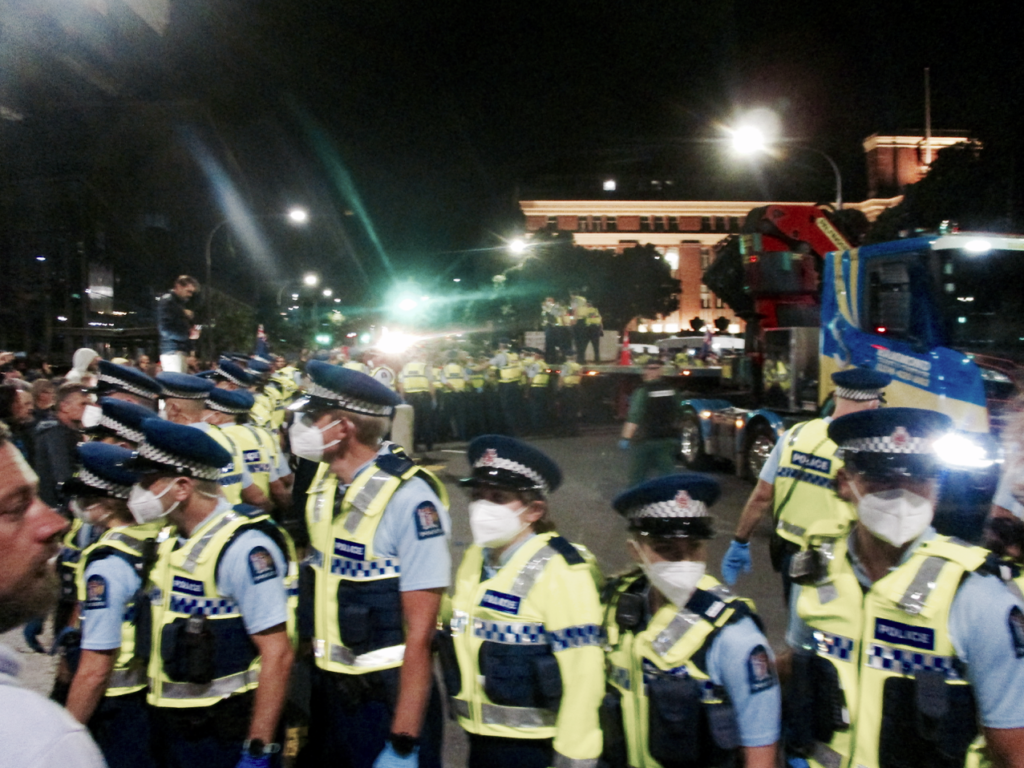
While two fork hoists zoomed back and forth to the trucks, the Police moved like parts of a machine to block the protesters, create space for the fork lift and tracks and the advancing trucks with their payloads of 15 half-tonne blocks.
Amidst this re-dawn activity, some protesters vented anger with expletives, ranting and cussing, while others spoke words of wisdom about occupiers protecting the freedom of New Zealanders — amid a couple outbreaks of shoving police.
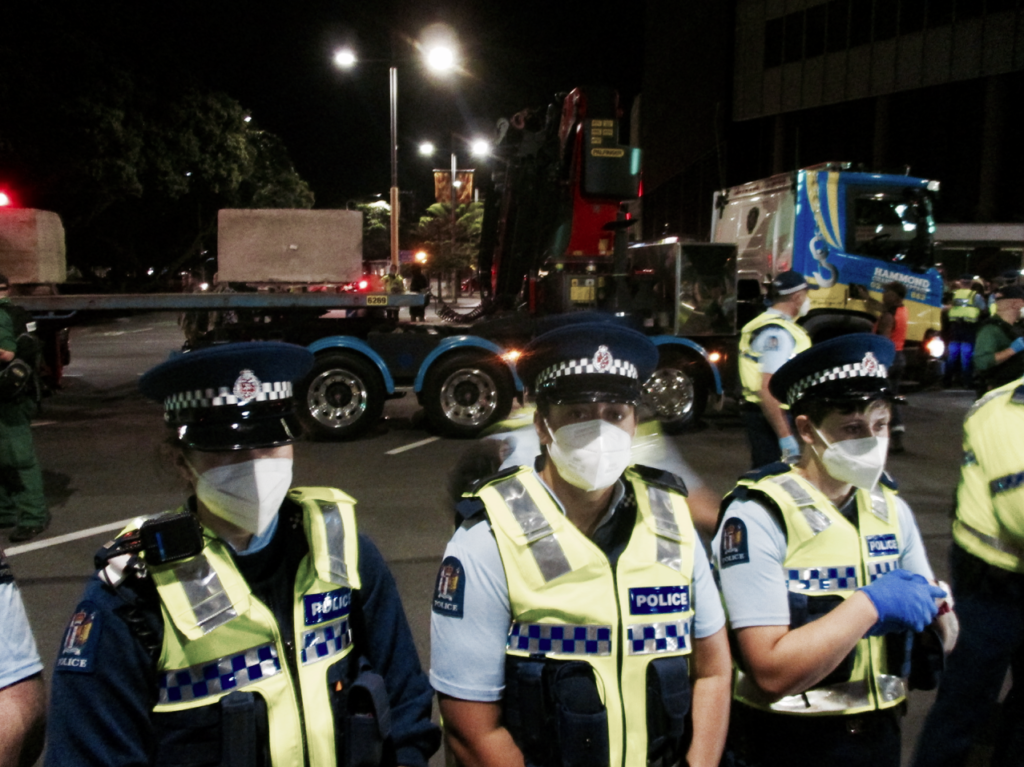
Two men climbed onto the tail-end of a flat-bed trailer and sat facing one another on a concrete block. Police mounted the trailer and attempted to prize the men from the truck. Police quickly became frustrated that they could not easily prize the men apart, because they had locked their forearms together and clasped each other hands.

The police resorted to punching the mens’ faces and heads. The man at the back of the trailer was pushed over the side and he fell onto Featherston Street. The other man was dragged off the truck. The two men were among about 10 free range humans who were taken into police custody by the time the sun rose over the capital of this troubled South Pacific Realm of the Fourth British Masonic Empire.
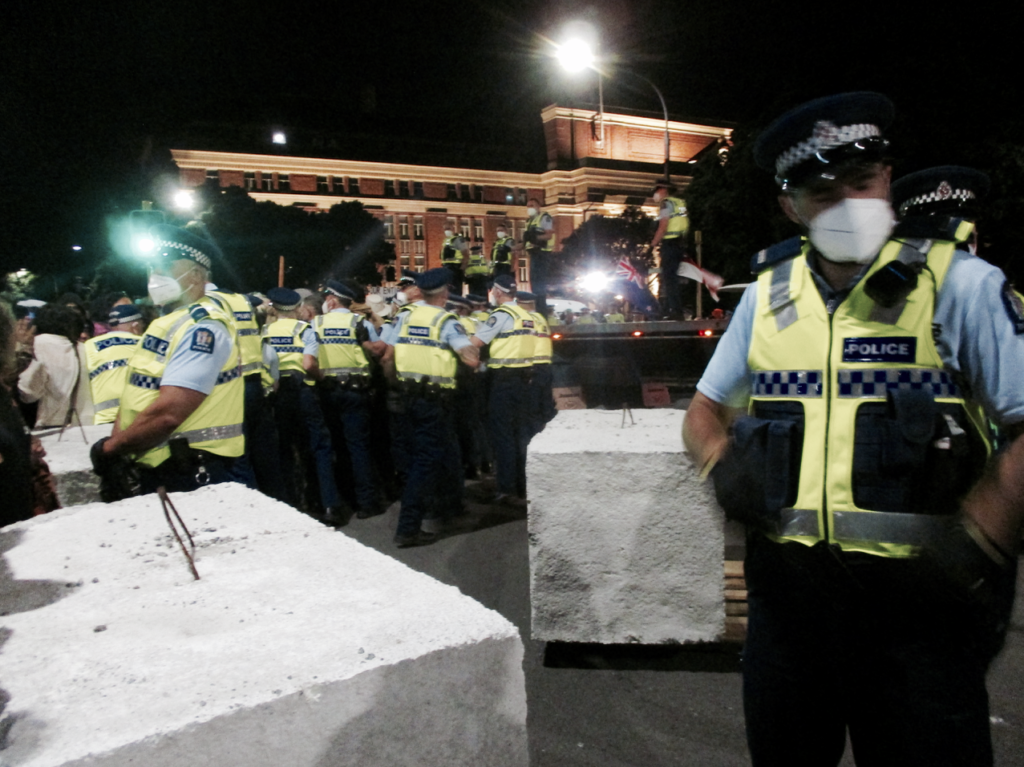
After the 15 blocks were set in their places, the police marched around to block the intersection of Lambton Quay, Bowen Street and Whitmore Street. At this intersection, police repeated their guerrilla warfare tactics of advancing to protect the placement of blocks.
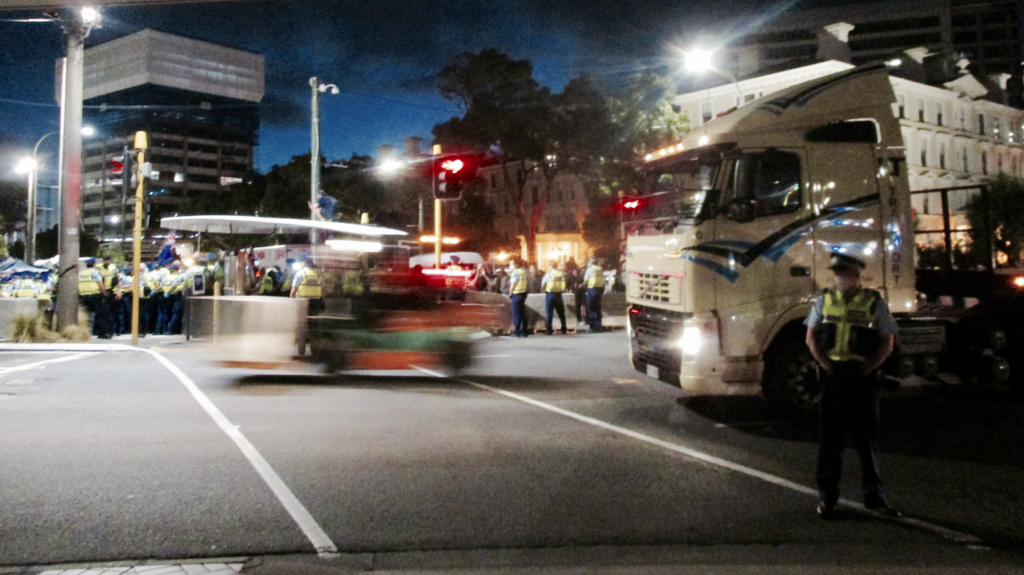
A few wrestles between police and protesters occurred at this intersection.
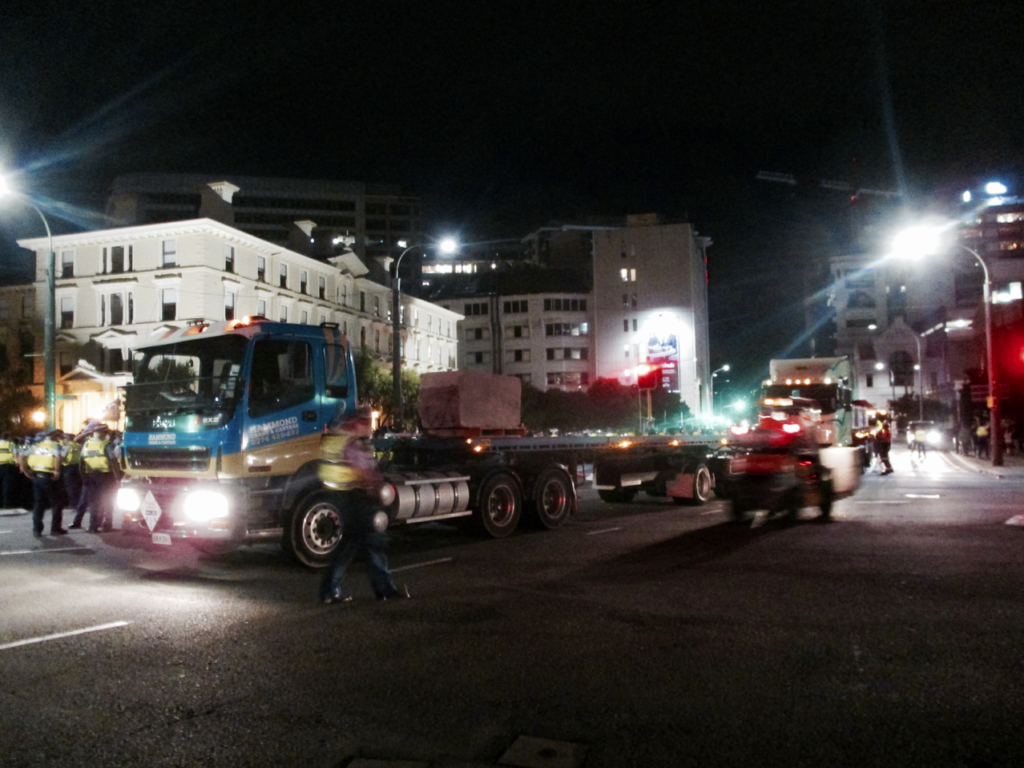
One fraccas happened when the Constabulary pushed the crowd back to make space for the fork-hoist driver to lay blocks to close off the turning lane from Whitmore Street into Bowen Street by the Masonic War Memorial Cenotaph, below the Masonic Beehive.
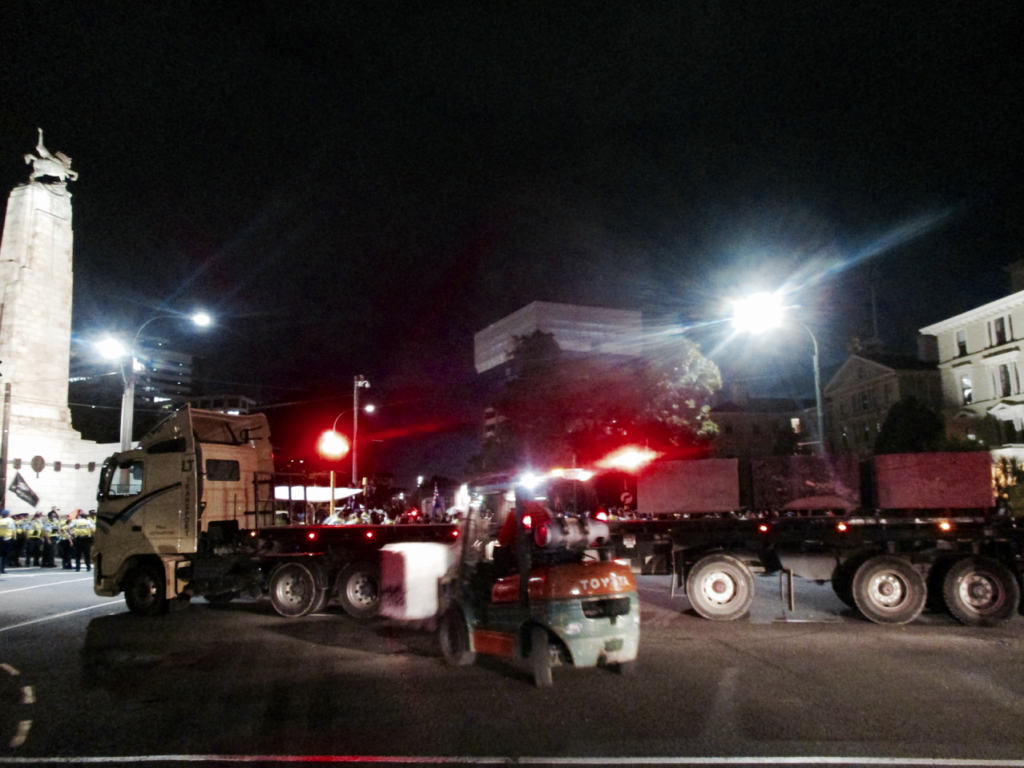
By blocking off Bowen Street, Police cut off access to the porto-loos with the effect that half the number of portable toilets may not be serviced at the present time.
Given that such guerrilla warfare tactics were used by British, Colonial and Constabulary forces during the New Zealand Masonic Revolutionary War of 1860-72, the dawn blockade operation to cut-off the supply chain of occupying Freedom Force in the capital city is in keeping with the New Zealand’s historical violent state formation.
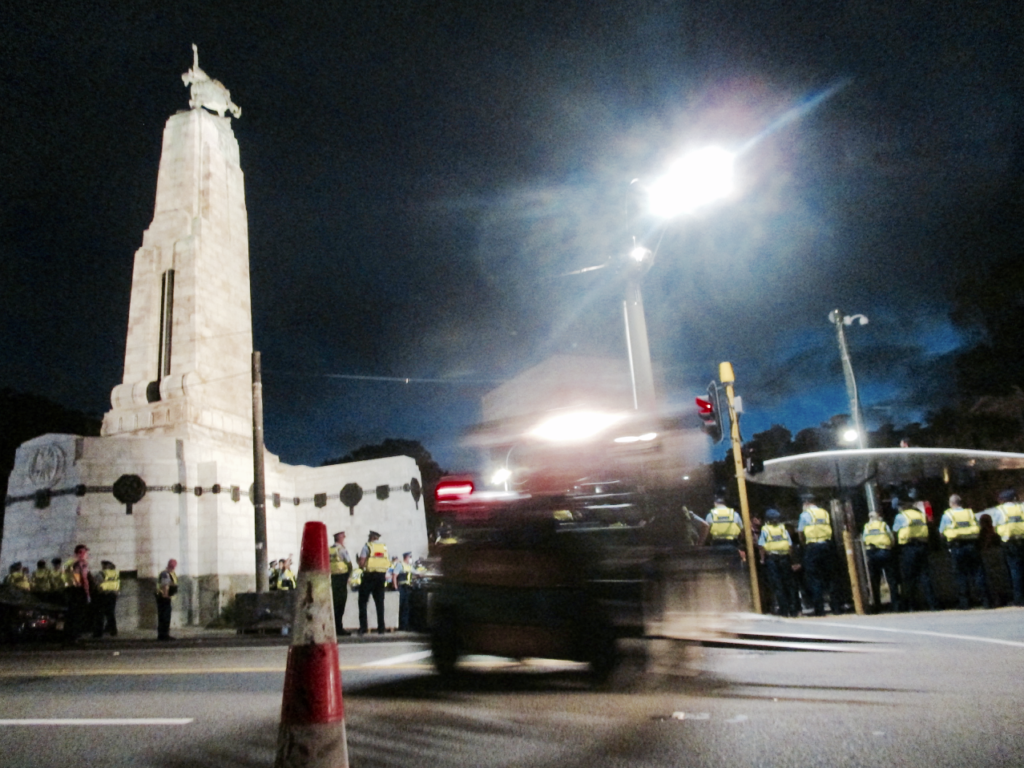
By early morning, the level-headed among those comprising Freedom Village viewed the mornings events as problems that could be matched with solutions, since the composition of the occupation is mostly working class people who are used to challenges.
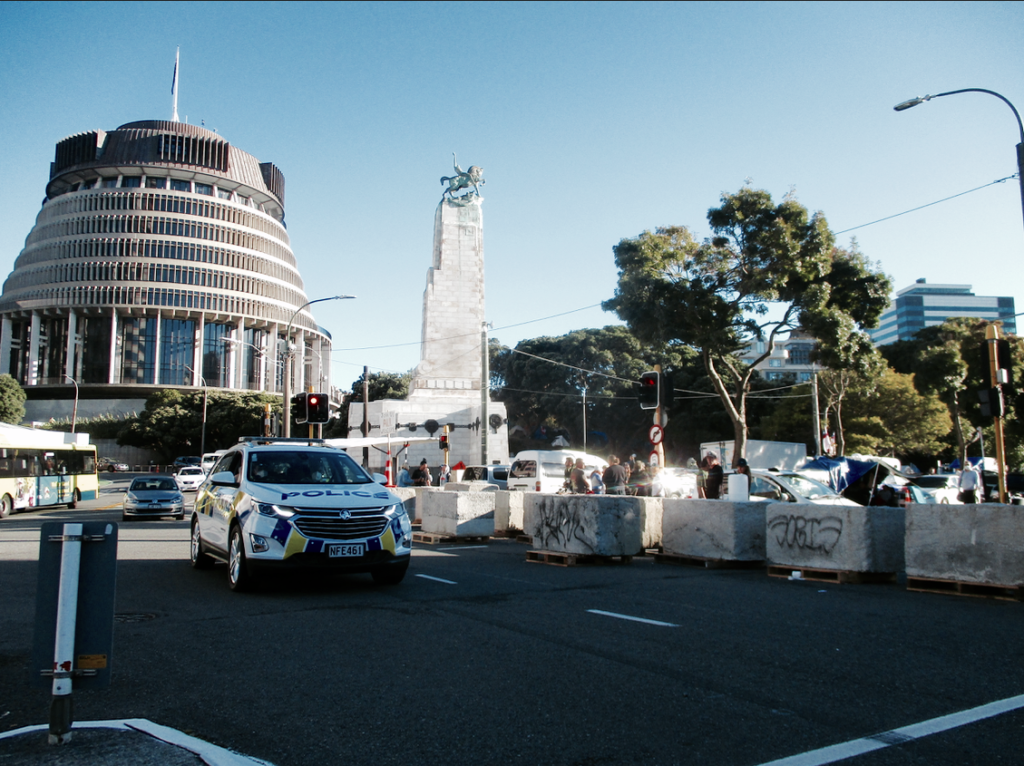
Eight people were arrested, seven for disorderly behaviour and one for obstruction, The New Zealand Herald reported.

By lunchtime, the port-o-loos were being serviced as usual. I hung around until the driver paused between sucking human effluent to ask him if he had any difficulty getting through the police cordon. He replied, “No, they let me straight through.”
As I finished writing this account in the morning light under a pohutukawa tree, I couldn’t help but notice in my photos that the pallets upon which the concrete blocks sit, are constructed of chemical-free heat-treated timber bearing the HT mark.
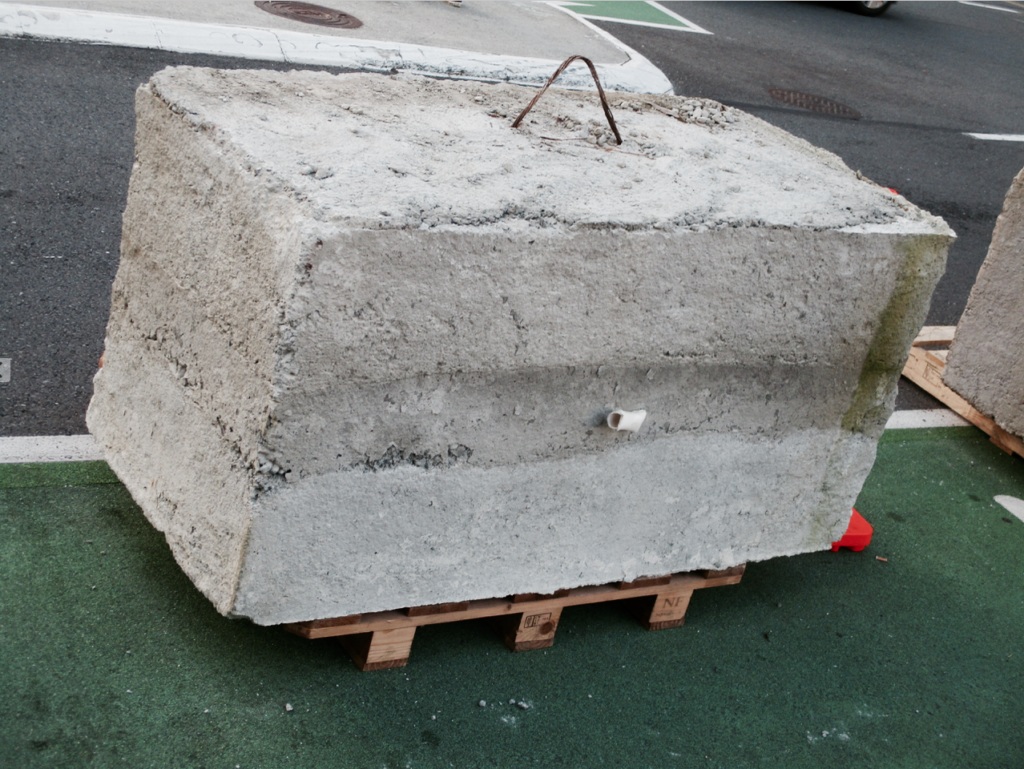
Such heat-treated timber makes them suitable for constructing food-growing planter boxes, raised garden bed frames and composting toilets.
======
Steve ‘Snoopman’ Edwards is a dissident journalist, who worked at indigenous broadcaster, Māori Television, for 14 years as an editor of news, current affairs and general programmes. He forged his ‘Thunk Evil Without Being Evil’ super-power while writing his ground-breaking thesis on the Global Financial Crisis (GFC), titled — “It’s the financial oligarchy, stupid” — to figure out the means, modus operandi and motives of the Anglo-American Oligarchy.
Editor’s Note: If we have made any errors, please contact our administrator, Steve Edwards, with your counter-evidence. e: steveedwards108[at]protonmail.com

